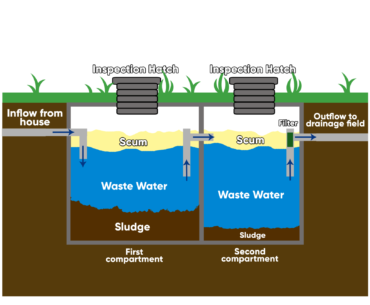How NOT to block your septic system
In order to best avoid blockages, you first need to understand how a septic system works….
The Septic tank is the main part of the wastewater treatment system. It’s the part that breaks down waste coming from your plumbing fixtures and holds the solids for removal. Waste is held in a large tank and is treated through natural and technological processes. Once the liquid and solid waste are separated, the wastewater flows from the tank out to the drain field.

Water flows from your plumbing into the first compartment of the septic tank. The solid waste settles to the bottom of the tank and the scum (mostly fats and fiber) floats to the surface.
The water then makes its way through a pipe into the second compartment where it goes through the same process.
This process filters out the majority of the solids from your waste but the addition of a filter can greatly reduce the particulates that make their way to the drainage field.
The settled solid waste must be regularly removed from both compartments in order for it to work properly.
An overflow of solid waste can block the transport pipes and even the outflow to the drainage field.
So, what’s the best way to stop this from happening?
- Keep up with regular maintenance.
Nothing stops a system from working faster than a full tank. Septic tanks should be emptied at least every 18 months (or sooner if an issue develops). Failure to remove the solid waste from your system can cause blockages resulting in costly repairs.
- Never flush anything other than the 3 p’s (poo, pee & paper.)
This is the holy trinity of happy drainage. Anything else is likely to cause your drains and septic system real problems.
Never flush baby wipes (including “biodegradable” ones), cleaning wipes, sanitary products or nappies down the toilet.
- Don’t plant trees near your septic tank.
We know that it can be tempting to plant trees and large shrubs near your septic tank but avoid the urge! Tree roots can make their way into septic tanks causing catastrophic damage and eventually system failure. Modern systems come with easily accessible but sympathetically designed access hatches to blend in with your garden planting.
- Try not to overload your system.
Careful consideration is taken to ensure that the size of the septic system is appropriate for the size of house. If your home has been extended/upgraded over the years there is a good chance that the number of occupants, bathrooms and water use devices (such as washing machines, dishwashers etc) exceeds the original system capabilities. Overloading your system will cause it to fill up with solid waste faster and it will struggle to effectively settle out the solid waste from the water. Upgrading your system isn’t as expensive as you may fear and it’s a good idea to do so before you overload your existing drainage field.
If you’re concerned about the effectiveness or efficiency of your system then our tech team are on hand to help.
Contact us here.